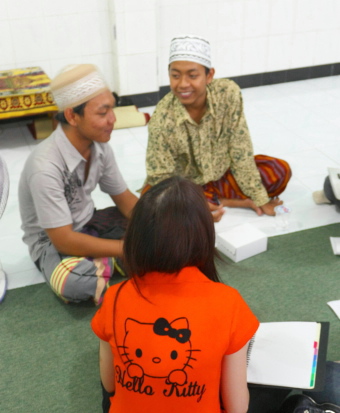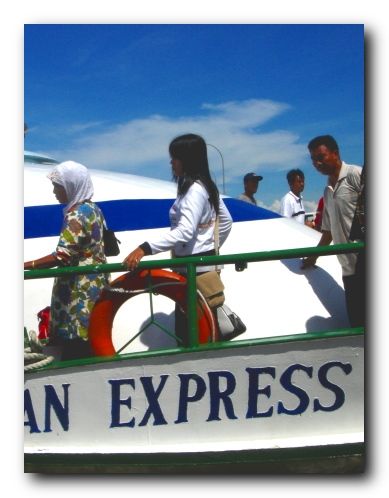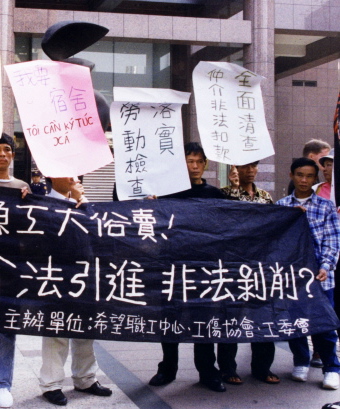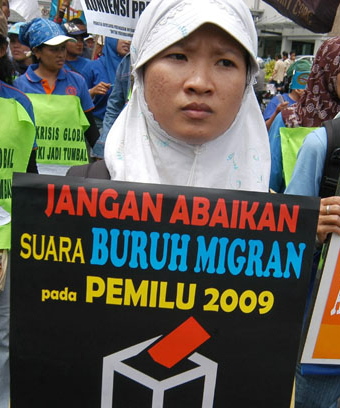Some inspirational efforts are being made to promote inter-religious understanding, but state schools are way behind
Lyn Parker
The ethnic, religious and linguistic diversity of Indonesia is built into the concept of Indonesia. However, under Suharto, it was forbidden to explore differences of class, ethnicity, 'race' and religion. The government made strenuous efforts to construct a homogeneous national culture - notably through the education system. Since Suharto, the freeing of the press, democratisation and the policies of regional autonomy and decentralisation have given free rein to the heightened expression of local ethnic and religious identities. Political elites of all stripes have played up such differences for their own advantage, leading to violent conflicts in several well-known trouble-spots around the nation. Fundamentalisms of most faiths have flourished, but it has been the Islamisation of the public sphere that has attracted the most attention internationally.
Indonesia is not an Islamic state, but it is expressly religious. The first principle of Pancasila, the state ideology, is belief in one God. The Constitution of 1945 guarantees religious freedom but not the freedom not to be religious. Indonesia recognises only six religions: Islam, Protestantism, Catholicism, Hinduism, Buddhism and Confucianism. All citizens must identify their religion as one of these six on their identity cards and in many official documents such as birth and marriage certificates. Indonesia has a significant minority of Protestant and Catholic Christians; adherents of Balinese and other variants of Hinduism such as Kaharingin Hinduism in Kalimantan and Tenggerese Hinduism; Buddhists and Confucians, as well as millions of adherents of local and other world religions. All of these peoples, with the exception of the last group and adherents of some sects such as Ahmadiyah, are now free to practise their religions. These final exceptions show that Indonesia still has a way to go.
Since 1998, relations between religions have become fraught. Perhaps an indicator of this is that Law 20/2003 legislated that school children should be taught their own religion by teachers of their own faith. The tension, and sometimes friction, between religions is obvious in many other fields: in inter-religious marriage, the building of houses of worship for minority religions in majority neighbourhoods and even the choice of greeting. In 2005, the Indonesian Council of Ulama (MUI) decreed that praying together with non-Muslims was prohibited for Muslims. In 2005 they issued a fatwa forbidding Muslims from marrying non-Muslims and in 2006 MUI outlawed the Islamic minority sect, Ahmadiyah, and pluralism, secularism and liberalism in general. These are some of the structural obstacles that stand in the way of those who are concerned that Indonesia is becoming less religiously tolerant, and for those people who see inter-faith education, interaction and 'mixing' as one way forward for Indonesia.
Teaching religion in state schools
Religion has always been a compulsory subject for school children at all levels in Indonesia. In most schools, religion has usually been taught for two classes per week. In 2003, the new Education Law stated that each school must provide teachers of the same religion for its students: Muslim teachers for Muslim students, Hindu teachers for Hindu students, and so on. Even private faith-based schools have to provide for their minority other-faith students, for example, a private Catholic school should provide Muslim teachers for its Muslim students. This legislation can be seen as a good thing, because the religious minorities in a school are acknowledged and receive proper education in their religion. Further, it should ensure that each religion is taught respectfully and knowledgeably. However, there are also stories of students of religious minorities having to move school or even move house, to new towns and cities, because schools have not been willing to provide teachers for minority students. It can be expensive for schools to provide one or two students with a special teacher, and some schools do not comply with this regulation.
The approach to teaching religion in state schools is a 'within religion' or confessional approach. The curriculum for each religion stresses the doctrines and morals of that religion. However, according to the curriculum, students of all religions should learn consistently, from primary through to senior high school, to 'be tolerant, and to guard harmony in personal as well as social life'. They should learn to be 'steadfast in facing the challenges, obstacles, and changes that arise in social interaction, in local, national, regional as well as global environments'. However, 'tolerance' cannot be said to receive much attention in religion classes. In the three years of Islamic education in senior high school, for instance, tolerance only gets a mention once in the Year 12 curriculum. In the Protestant curriculum the word does not appear, though 'Christian values' (unspecified) are taught intensively. In addition Year 12 students are to 'develop a critical attitude towards democratic values and human rights' and to facilitate the introduction of 'good news and prosperous peace in private life and in the community'. The curriculum for the school subject Citizenship Education advises that students should be taught to value equally the various ways of life of other citizens in the country, 'without distinguishing race, religion, gender, group, culture and ethnicity'. However, this is the single mention of religion in the subject's curriculum. In all of these subjects there is no attempt to teach across religions or about other religions in a way that promotes understanding that other religions might have value. There is recognition that other religions have the right to exist in Indonesia, but no curiosity about them. There is very little structural support for teaching that enables students to understand and value other religions.
Given the inflamed national situation, it is not surprising that religious education has become politicised. Several Indonesian scholars have weighed into the debate. In 2003, RELIEF, Journal of Religious Issues, published by Gajah Mada University, ran an editorial which concluded that 'our religious education is becoming increasingly dogmatic, exclusive [and] rigid'. In 2008, the National Islamic University in Jakarta's Centre for Islamic and Social Studies conducted a survey of 500 religion teachers in senior high schools (including vocational schools) in several cities in Java. Results indicate general opposition by religion teachers to teaching religious pluralism in schools, with 87 per cent not advocating the study of other religions. It also revealed a less-than-tolerant attitude generally, with the majority not wanting a non-Muslim school principal. According to the Centre's director, Dr Burhanuddin, this 'anti-pluralist view' of school religion teachers is reflected in their school lessons, and contributes to the growth of conservatism and radicalism in Indonesian Muslim circles. It seems that the Ministries of Religion and National Education are failing to come to terms with what religious tolerance and pluralism might mean, especially in relation to meeting the challenges of global citizenship.
Teaching for tolerance
Some individual teachers make an enormous effort to promote inter-religious tolerance. A religion teacher at a private Islamic school in Yogyakarta bases her teaching on life experience and social issues such as abortion, domestic violence and polygamy. She might bring a clipping from a newspaper that presents a current issue, or she might show a documentary film then ask her students to reflect upon it critically and try to develop a response from within their own discussions. Her students' attitudes are testament to the efficacy of her teaching for religious pluralism. As one student put it, ideally, Indonesians would 'respect one another and value one another. In Indonesia there are many cultures: we should all become one. Indeed God was just in creating humankind with a variety of cultures and religions.'
Sometimes it is the school that makes the effort, or at least provides a whole-school environment that encourages the peaceful co-existence of different religions. The teacher at a private Catholic school who teaches his students humanism, rather than doctrine or comparative religion, has the support of the principal and the school administration. When prospective students and their parents are interviewed, they are warned that the school does not teach Catholicism. Instead, the school says it will teach the 'meeting' of religions, as a dialogue, using an interactive approach and teaching materials that are not from any particular religion. The foundation that runs the school wanted it to be a 'multicultural laboratory' that would value all people, of any background: it was to be an inclusive school, that bridged differences. Students are encouraged to 'dig' for themselves. In one lesson they interviewed strangers on the street, to find out what their faith meant to them. Many students chose to interview people from the middle to lower classes. They receive praise for this from their teacher, who believed that the well-off students at this school needed to learn how to mix with 'people of all types and classes'. Reflecting on this experience, one student concluded that 'This person taught me to value other people's spirituality and opinions, no matter who they are.' Another said, 'I learned that spirituality is useful in everyday life, helping people to overcome their problems'.
However, these laudable efforts at teaching for tolerance are isolated efforts that rely on the good will and energy of individual teachers, and sometimes the school. These are limitations, and it would be a good idea for some of these experimental projects to be evaluated. It would also behove state schools to take a look at these 'multicultural laboratories'.
Action in universities
There are also interesting initiatives in some universities. Gajah Mada University in Yogyakarta has an impressive Centre for Cross-Religious Studies for postgraduate students. This is a really active research centre which hosts seminars and conferences and sponsors research, with good links to the Yogyakarta Sunan Kalijaga State Islamic University. Postgraduate students from here and other state Islamic universities are doing some excellent work in this 'space between religions'. They not only produce theses on traditional religious topics such as theology, but also look across religions at comparative theology or work on the sociology of religion. The state Islamic universities, notably in Jakarta and Yogyakarta, have long been active in the inter-faith area. Sunan Kalijaga University has joined with the Duta Wacana Christian University in Yogyakarta to run a joint course for postgraduate theology students. This innovative course, known as the Cross-Religion School, runs for the academic year, during which the students (and other interested individuals) visit places of worship, attend religious services and study a range of different religions. Some of the next generation state Islamic universities are making strenuous efforts in this area too. For example, the Alauddin State Islamic University in Makassar hosted a conference on Multicultural Education last October and another earlier this year on Islam and Democracy.
In Surabaya, Petra Christian University has designed an innovative program to promote understanding of Islam by having two classes of business students visit a pesantren (Islamic boarding school) in Surabaya. Most students in this university are Chinese. The students and teachers at the pesantren warmly welcomed the Chinese Christian students and took part in interviews and small-group discussions with them. Some students followed up with more discussions, and when the business students presented their results, some of the people from the pesantren returned to form part of the audience. Student presentations and assignments were very revealing: many of the Christian students come from very comfortable, upper middle class families, and they were as much confronted by the living conditions at the boarding school as by the different faith. Nevertheless, as their class presentations showed, the interaction produced a demonstrable shift in their attitudes towards Muslims.
Some of these universities are elite and are producing the next generation of Indonesia's political, academic, economic and social leaders. It is encouraging that at least some of their students are being encouraged to learn how to live in harmony with people of other religions.
NGOs lead inter-faith dialogue
NGOs are playing an important role in initiating, mediating and organising such experiments. In Jakarta, organisations such as the Indonesian Conference on Religion and Peace, The Wahid Institute and Kapal Perempuan run a range of activities that include seminars for young people and women, publishing, library services, training courses and research on inter-faith communication, tolerance and peace-building. One of the most important and enduring NGOs is Interfidei, in Yogyakarta, which is organising and leading the Cross-Religion School. Interfidei has played a prominent role in the promotion of inter-faith dialogue, publishing, commissioning research, organising visits by international experts and leading seminars. Its work is specifically inter-religious, and it is highly respected.
Other NGOs conduct programs that are not specifically inter-religious but nevertheless foster inclusivity, multiculturalism and inter-religious communication. For instance, in fervently Islamic South Sulawesi, Christian activists prefer to work alongside Muslims on anti-poverty and development projects rather than in explicitly inter-faith groups.
 |
|
An NGO worker explains how to develop a story-board / Lyn Parker |
The Institute for Islamic and Social Studies, a long-standing NGO in Yogyakarta, runs creative writing courses for young people, which produce the well-known magazine Coret, as well as workshop courses for high school students on video documentary-making. Students from various schools, including a vocational school and an Islamic school, come together on Sundays to learn how to develop a topic and story-board collaboratively, study photographic techniques and eventually produce group videos on topics of their own choosing and development. Apart from the skills of film-making, the course aims to give young people the opportunity to socialise with the opposite sex and with others from different schools and to have them experience an egalitarian, student-centred, activity-based, cooperative learning process. One of the DVDs they produced, Mata Muda (Young Eyes), presents eight short films on topics ranging from life in a pesantren to the life of a street busker.
Much good educational work aimed at peaceful co-existence appears to be happening outside state schools, not inside. NGOs are leading the way. While it is great that individuals, NGOs, universities and some teachers at private schools are making valiant efforts, it is also worrying that inter-faith education and teaching for religious tolerance are not better embedded in school curricula and structurally supported in the national school system. There are some valuable experiments in teaching for religious tolerance being made around the country. Education has a contribution to make in helping the different religious communities live together peacefully.
Lyn Parker (lyn.parker@uwa.edu.au) is a Professor in Asian Studies at the University of Western Australia. She is leading a large ARC-funded project on education for a multicultural Indonesia.














